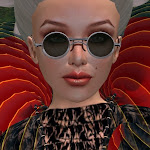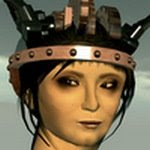2008 has already been a landmark year for art in virtual worlds. It is the year that Brooklyn is Watching gently dipped its toes in Second Life® and found itself nearly crushed by a multitude of artists and artwork. Babelswarm, the winner of the Australia Council for the Arts' Second Life arts residency, came to life. Blackthorn Hare got his Masters degree in Second Life sculpture. This year also marked the launch of Arthole, which I will write about soon, and the opening of the Kirsti Aho Museum, and one week ago, we celebrated the unveiling of our Garden, simply the largest collection - ever - of content creation that is not possible in Real Life.
Meanwhile, another show just debuted that is critical to our understanding of the unique possibilities in a 3D virtual medium, and the list of participants reads like a Who's Who of virtual abstract art. I welcome guest blogger Bjorlyn Loon, and her insightful piece on this collection.
by Bjorlyn Loon
DanCoyote Antonelli’s (aka DC Spensley) new exhibit, Kiss the Sky, is an historical document in recognition of a community of artists in Second Life. Like most of us, artists and critics are searching for new words and constructs to define their virtual experience. Says Antonelli: “Since virtual worlds are a change of venue – a drastic change of venue – the former critical language is not enough.”
Dancoyote Antonelli: "The people in this show are each like a Picasso, or like the abstract expressionists of our time. They have embraced virtual world conditions, and are representing an avant-garde within an avant-garde that is nearly incomprehensible in material-world art. Feel the history, we are living in it!
One of the reasons that Hyperformalism has not mainstreamed until now is that there are a lot of practitioners that are not communicating with each other. In Second Life Hyperformalism has found a home in that it is an indigenous art form. Hyperformal work has always existed uncomfortably in the material sphere.
While space in virtual worlds is a simulation, place can be real. In fact, art experiences are the only thing that can be real in both the virtual and material worlds at the same time.” Kiss the Sky is tiered in the air above New Media Consortium’s NMC Arts Lab (teleport directly from here), and visitors are encouraged to interact with the works, and to experience them on many levels, including sight, sound and play.
Not all of this work is brand spanking new: it is not intended to be. What is new about it is that it is all together. This is a survey, a critical milestone to mark this time in history and present the shared histories of these artists in one concentrated punch.”
In addition to work from DanCoyote Antonelli, Kiss the Sky artists include Chance Abattoir, Vlad Bjornson, nand Nerd, Selavy Oh, Adam Ramona, Nebulosus Severine, AngryBeth Shortbread, Sasun Steinbeck, Sabine Stonebender, Seifert Surface, elros Tuominen, Juria Yoshikawa, and i7o Zhu.
Antonelli has developed a new native architecture for experiencing this exhibit, which might otherwise be difficult to maneuver as a result of its massive scale. Strategically placed purple seats call up a menu where you can select from among the 35 works in the exhibit, and the seat will gently transport you to your choice. Says Antonelli, “What is important is that there is no remediated architecture here: Interface serves content. The seats take you to all the exhibits, near the sign that only opens when you are near enough to read. The signs and seats are in the same place in each exhibit, so once you get it, you have it.”
Hyperformalism is non-figurative abstraction in a hyper-medium, including abstract objects arranged in simulated space, navigable on a network, as well as expressions of reactive and interactive artwork behaviors and geometric or algorithmic pattern play in 2, 3, and 4 dimensions. Because Hyperformalist works are unique created entities that are not representational, viewer relationships are less fettered by pre-existing symbolic weight and the artworks encourage fascination with form and pure relationships. The virtual world provides the ability to liberate the work from scale constraints and provides a perfect context for this post-conceptualist movement.
Juria Yoshikawa’s creation embraces Kiss the Sky in sheer physical dimensions. "In all three of my works, as the name of the show Kiss the Sky suggested,” says Yoshikawa, “I tried to create forms to pull people in and draw them skyward. In the large piece Infinite Pixel Loop most of all, I was aiming at a reaction of immersive upward motion."
Conversely, the pulsating rock specatacle of i7o’s Zhu Name Unknown contrasts with the aerial setting of Kiss the Sky, suggesting a literal and conceptual grounding. 
According to the artist, Adam Ramona’s works in Kiss The Sky “explore the audiovisual relationship between the avatar and virtual space. Sound and vision are created and modified dynamically by the avatar's movement through space, creating a real-time composition unique to that user and time.” Seen here: A Rose Heard At Dusk
Seifert Surface is directly concerned with the mathematics of 3D, which Antonelli describes as “one genre of hyperformalism.” For example, Surface’s Spore, created in 2006, “is based on a process that turns up in nature a lot: 'growing' new objects around some axis at an angle of 2pi/Phi from the previous one, where Phi is the golden ratio, (1+sqrt(5))/2.” Siefert’s Meandering Hypercube “is a projection of the hypercube from 4d to the 3d of Second Life, just as the 3d of Second Life projects to the 2d of a computer screen.” 
Veteran artist Sabine Stonebender describes her KissTS – MoreAndLess as “Positive space vs. Negative space in an endless cycle,” and it is mesmerizing. 
Of his Plant Deco installation, artist Vlad Bjornson says “The changing, geometric shapes of each piece are fractal and self-similar in nature, somewhat like the structure of Real Life plants. The colors of each piece were inspired by some of my favorite artists, borrowing color pallets from their works. Each piece changes to a unique configuration each time it is touched, with billions of possible combinations.” 
AngryBeth Shortbread extends her Real Life art into Second Life with a strong emphasis on sound, play, and interactivity. Her Pusher-Tron is no exception.
Nand Nerd, who refers to himself as an… “Artist? I'm no artist. What would I know about art? I'm an Engineer, damnit,” has always been intrigued by Antonelli’s art. “The flexi-hedra started off as a whimsical use of the new flexible path feature,” says Nerd, “Once I'd seen the outcome I was hooked and developed a range of polyhedra to be given the same treatment.” Nerd’s Square Antiprism Tower at Kiss the Sky responds to touch in unexpected ways, which defy gravity.
Nebulosus Severine, who has been working in Second Life since 2005, produces works which she describes as “Chromotive [Chroma (color) + Emotive (drawing out or evoking emotion)].” Her Pulse Points (I, II, III) is a crystalline structure which surrounds the avatar in pulsating light. 
Chance Abattoir is interested in interactivity, and brings skills in texturing, building, 3d modeling, and scripting to the artistic task. His 5.3.5(2) juxtaposes dissimilar shapes which evolve according to the angle of view, and change further, and more dramatically, upon touch. Chance elaborates, “It's not meant to convey anything other than self-reflexivity. Each part of the art refers to another part of the art.” 
In the year and a half that elros Tuominen has been in Second Life, he says that he has “never stopped learning about building, scripting, textures... I feel like a child, playing with everything I find, and expressing myself freely.” Tuominen is a prolific artist, treating his friends to new poetry or sculpture every single day. For elros, Underconstruction City v.06 is a massive work, demonstrating his increasing mastery of the medium, and communicating his expanding reach towards impossibilities. 
Sasun Steinbeck has been working on her Morphing Sculpture for years, perfecting it. It scintillates against a starry night sky or cloudless blue with equal impact. Like many of the works within Kiss the Sky, Steinbeck’s is configurable by the visitor, in this case via choices of texture. 
Selavy Oh describes her Soft Structure as “part of a series of conceptual works exploring and utilizing inherent properties of the simulated world of Second Life. Motion of the structure is created by virtual wind, the color reflects cloud density, and the cloud-like fragility of the installation is emphasized by temporarily dispersing the elements upon avatar intrusion.”
In sum, for all their differences, the works of art in Kiss the Sky achieve Antonelli’s goal of creating a historical node. People will look back at this exhibition, with the experience of years, and see a tipping point, where, according to Antonelli, “Hyperformalists on Second Life have more in common with each other than we do with the material or conceptual art worlds.”
All photos by Bjorlyn Loon, with these exceptions: Overview: Antonelli, Infinite Pixel Loop: Yoshikawa, Morphing Sculpture: Steinbeck, A Rose Heard At Dusk: Ramona, Pulse Points (I, II, III): Severine, and Soft Sculpture: Oh.
Friday, May 23, 2008
Kiss the Sky: Tipping point on the axis of a virtual world
Posted by
Bettina Tizzy
at
8:48 AM
![]()
Labels: abstract, art, Bjorlyn Loon, DanCoyote Antonelli, Garden of NPIRL Delights, Hyperformalism, Kiss the Sky, New Media Consortium, Not Possible IRL, Second Life®, virtual worlds








1 comments:
It seems SL art is coming of age. DanCoyote Antonelli's "DC-07-026" is particularly fascinating. See it!
Post a Comment